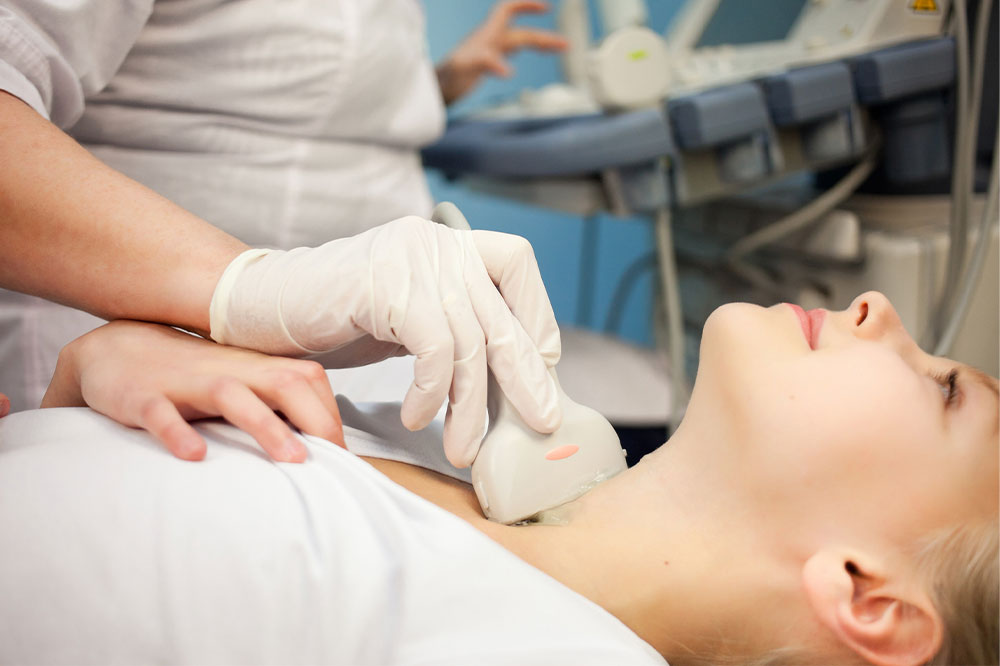Thyroid Cancer – Warning Signs, Risks, and Diagnosis

Thyroid cancer occurs when malignant cells form in the thyroid gland, which produces hormones that regulate body temperature, heart rate, and metabolism. It is the fifth most common cancer found in women in the country. This condition may not cause symptoms in the early stages and is often discovered during a routine neck examination or imaging scan. Knowing the risks, warning signs, and symptoms may help diagnose and treat the condition successfully.
What is the thyroid gland?
The small butterfly-shaped thyroid gland is situated around the trachea, at the base of the neck. It is one of the most vital hormone glands, affecting most bodily functions. The thyroid regulates the metabolism, growth, and development of the human body. The two main hormones secreted by the thyroid gland are thyroxine (T4) and triiodothyronine (T3).
What are the warning signs of thyroid cancer?
Thyroid cancer is classified by the type of cancer cell. Some of these include papillary cancer, follicular thyroid cancer, Hurthle cell cancer, sporadic medullary thyroid cancer, familial medullary thyroid cancer, anaplastic thyroid cancer, and thyroid lymphoma. Although it is tough to identify thyroid cancer until its advanced stages, here are some early warning signs to be wary of:
- Swollen lump on the neck
An unusual lump, swelling, or nodule in the neck is generally one of the most common signs of thyroid cancer. If one experiences such abnormal growth, it is advisable to visit the doctor to have it checked and run additional tests if needed. This can help identify if the tumor is benign or malignant and make way for early treatment and recovery. - Fatigue
Although this is a common symptom associated with most cancers, it is often overlooked. Those who have been feeling more tired than usual must visit their primary care physician to diagnose the underlying cause. - Swollen glands in the neck
When cancer spreads to the surrounding lymph nodes, it may cause swelling in the neck. - Persistent cough
When tumors or nodules grow in the thyroid, they often lead to constant irritation and a persistent cough. If one experiences this even after their cold or illness has passed, it may be a warning sign of thyroid cancer and must be checked immediately. - Neck pain
Thyroid pain also causes neck pain (that may extend up to the ear) in many cases. - Voice changes
Some people may experience a hoarse voice or unusual voice changes in the early stages of thyroid cancer. - Breathing problems
Due to the tumorous growth around the throat, many people with thyroid cancer also complain of breathing difficulties. It is often described as the sensation of breathing through a straw. - Trouble swallowing
Just like breathing, growths or nodules around the throat may restrict the passage of food and fluids, causing pain or discomfort during swallowing.
Symptoms of recurrent thyroid cancer
Like most forms of cancer, thyroid cancer too may return after treatment. Up to 30% of thyroid cancer patients may experience recurrence, especially around the neck area. Some symptoms of thyroid cancer recurrence include:
- Swelling or lump in the neck
- Neck pain that starts in the neck and may extend up to the back of the ears
- Trouble breathing or swallowing
- Voice changes or hoarseness
- Continuous cough that is not related to a cold
Thyroid cancer also has a 95% 5-year survival rate. This means that 95% of people diagnosed with thyroid cancer might live for 5 years after diagnosis. However, early detection and being cognizant of one’s symptoms are vital. Visiting the doctor for regular screenings and check-ups may help detect cancer early and begin treatment at its nascent stages. Doctors may also recommend physical exams, blood tests, or imaging tests such as radioiodine scans and ultrasounds.
What are the risk factors associated with thyroid cancer?
Several factors may increase one’s risk of developing thyroid cancer. These include:
- Gender
Women and people assigned female at birth (AFAB) are three times more likely to be diagnosed with thyroid cancer, in comparison to men, most likely due to the presence of estrogen in the body. - Overexposure to radiation
Being overexposed to radiation in one’s childhood, such as x-rays or radiation therapies, can also significantly increase one’s risk for thyroid cancer. - Inherited genetic conditions
Several genetic conditions can increase one’s predisposition to cancer. Some of these include multiple endocrine neoplasia, Cowden syndrome, and familial adenomatous polyposis. Having a family history of thyroid cancer, especially medullary and papillary thyroid cancer, may also significantly increase one’s risk of developing the condition.
How is thyroid cancer diagnosed?
Several lab tests and procedures are used to diagnose thyroid cancer. These include:
- Core biopsy
During a biopsy, the doctor removes some thyroid cells to test, which helps determine the type of cancer. - Thyroid function tests
These tests measure the level of thyroid hormones in the blood to ensure that the gland is working effectively. - Thyroid ultrasound
Ultrasound tests use sound waves to show images of the thyroid gland. This helps identify any abnormalities or suspicious nodule growths and determine the spread of cancer around the throat. - CT and MRI scans
When doctors need to look closer at the spread of thyroid cancer, they may recommend a computerized tomography (CT) or magnetic resonance imaging (MRI) scan. - Thyroid scan
During this test, a small amount of radioactive iodine is used to test the thyroid function.
Depending on the type, location, and stage of cancer, doctors will formulate a treatment plan. This may include surgery, radioiodine therapy, external beam radiation therapy, or chemotherapy. When diagnosis and treatment begin in the early stages of thyroid cancer, people have a higher chance of recovery and remission.



